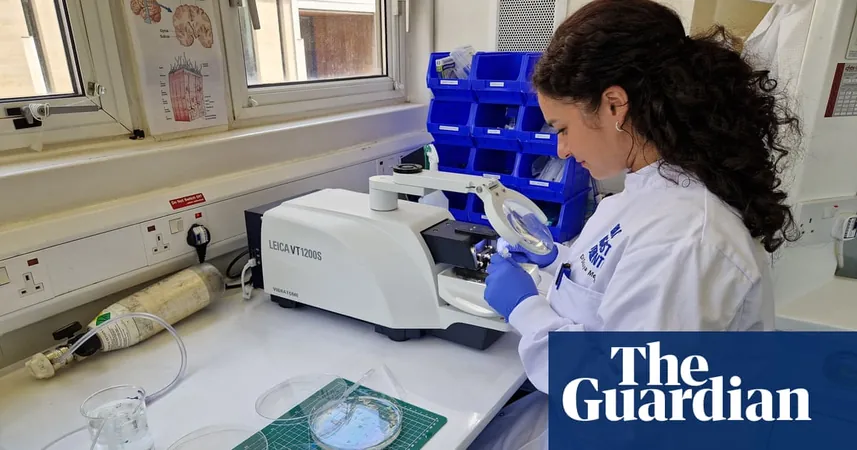
Revolutionary Breakthrough: Scientists Use Live Human Brain Tissue to Advance Alzheimer's Research
2025-04-30
Author: Li
In an unprecedented scientific breakthrough, researchers have harnessed living human brain tissue to replicate the early stages of Alzheimer’s disease—the most prevalent form of dementia. This innovative approach is set to significantly expedite the search for effective treatments.
A pioneering team from Britain has made history by exposing healthy brain tissue from living NHS patients to a toxic variant of the protein linked to Alzheimer’s, revealing in real-time how it devastates connections between brain cells.
A New Era in Dementia Research
This groundbreaking technique allows scientists to observe the progression of dementia at the cellular level, offering a potent new avenue for testing potential drugs and increasing the odds of discovering effective therapies.
With dementia posing a monumental strain on global health systems—projected to affect nearly 153 million individuals by 2050—innovative study methods like this are crucial as we race to find effective treatments.
How The Study Was Conducted
In an impressive collaboration with Edinburgh neurosurgeons, researchers demonstrated how the amyloid beta protein, notorious for its role in Alzheimer’s, attaches to and disrupts essential connections between neurons.
During routine surgeries to remove tumors at the Royal Infirmary of Edinburgh, tiny fragments of healthy brain tissue were sourced from cancer patients. Scientists, ready in scrubs, were stationed alongside surgical teams to immediately collect these samples.
Once harvested, these precious brain pieces were transported in glass bottles filled with oxygenated artificial spinal fluid. Dr. Claire Durrant, a key researcher, noted, "We practically ran back to the lab," eager to begin their experiments.
Mimicking Alzheimer’s in Real-Time
In the lab, the samples were carefully sliced into ultra-thin pieces and placed in nutrient-rich environments at body temperature. This allowed the researchers to maintain the brain tissue alive for up to two weeks with patient consent.
By applying the toxic form of amyloid beta harvested from deceased Alzheimer's patients, Durrant and her team aimed to recreate the conditions of Alzheimer’s disease. Unlike normal protein, exposure to the toxic variant halted the brain’s attempts to repair itself.
Unlocking the Mysteries of Alzheimer’s
This research illuminates the delicate balance of amyloid beta levels needed for healthy brain functionality. Even slight variations in these levels can impair neuronal health, suggesting a complex interplay crucial for cognitive performance.
Dr. Durrant emphasized, "Our collaboration with neurosurgeons at the University of Edinburgh has revealed that living human brain slices can be instrumental in addressing fundamental questions about Alzheimer’s disease." She expressed hope that this pioneering method could bridge the gap between lab discoveries and real-world applications.
Promise for the Future
The implications of this study are extensive, particularly in identifying drugs that could prevent the loss of synapses—the lifeline of brain cell communication. Loss of synapses correlates strongly with diminished memory and cognitive abilities in Alzheimer’s patients.
Interestingly, slices from the temporal lobe—an area typically affected early by Alzheimer's—released elevated levels of tau, another crucial protein, potentially elucidating this region's vulnerability.
Supported by Race Against Dementia and a generous donation from the James Dyson Foundation, this research signifies a vital step toward addressing one of society’s most pressing health challenges.
Dyson hailed the method as transformative, enabling researchers to investigate Alzheimer’s using real human brain cells rather than animal models. Prof Tara Spires-Jones from the UK Dementia Research Institute echoed these sentiments, recognizing the study's potential to revolutionize our understanding and treatment of Alzheimer's.



 Brasil (PT)
Brasil (PT)
 Canada (EN)
Canada (EN)
 Chile (ES)
Chile (ES)
 Česko (CS)
Česko (CS)
 대한민국 (KO)
대한민국 (KO)
 España (ES)
España (ES)
 France (FR)
France (FR)
 Hong Kong (EN)
Hong Kong (EN)
 Italia (IT)
Italia (IT)
 日本 (JA)
日本 (JA)
 Magyarország (HU)
Magyarország (HU)
 Norge (NO)
Norge (NO)
 Polska (PL)
Polska (PL)
 Schweiz (DE)
Schweiz (DE)
 Singapore (EN)
Singapore (EN)
 Sverige (SV)
Sverige (SV)
 Suomi (FI)
Suomi (FI)
 Türkiye (TR)
Türkiye (TR)
 الإمارات العربية المتحدة (AR)
الإمارات العربية المتحدة (AR)